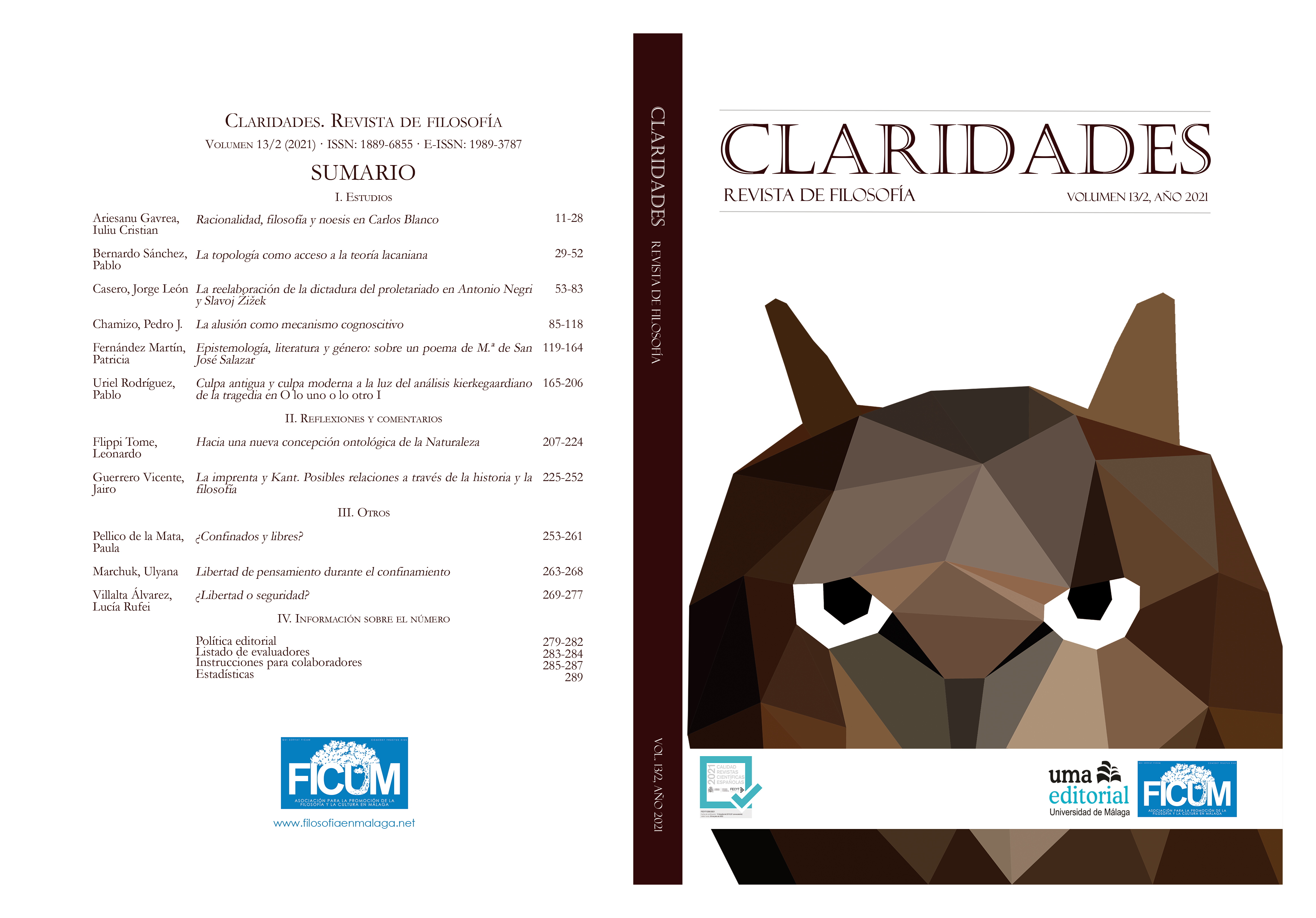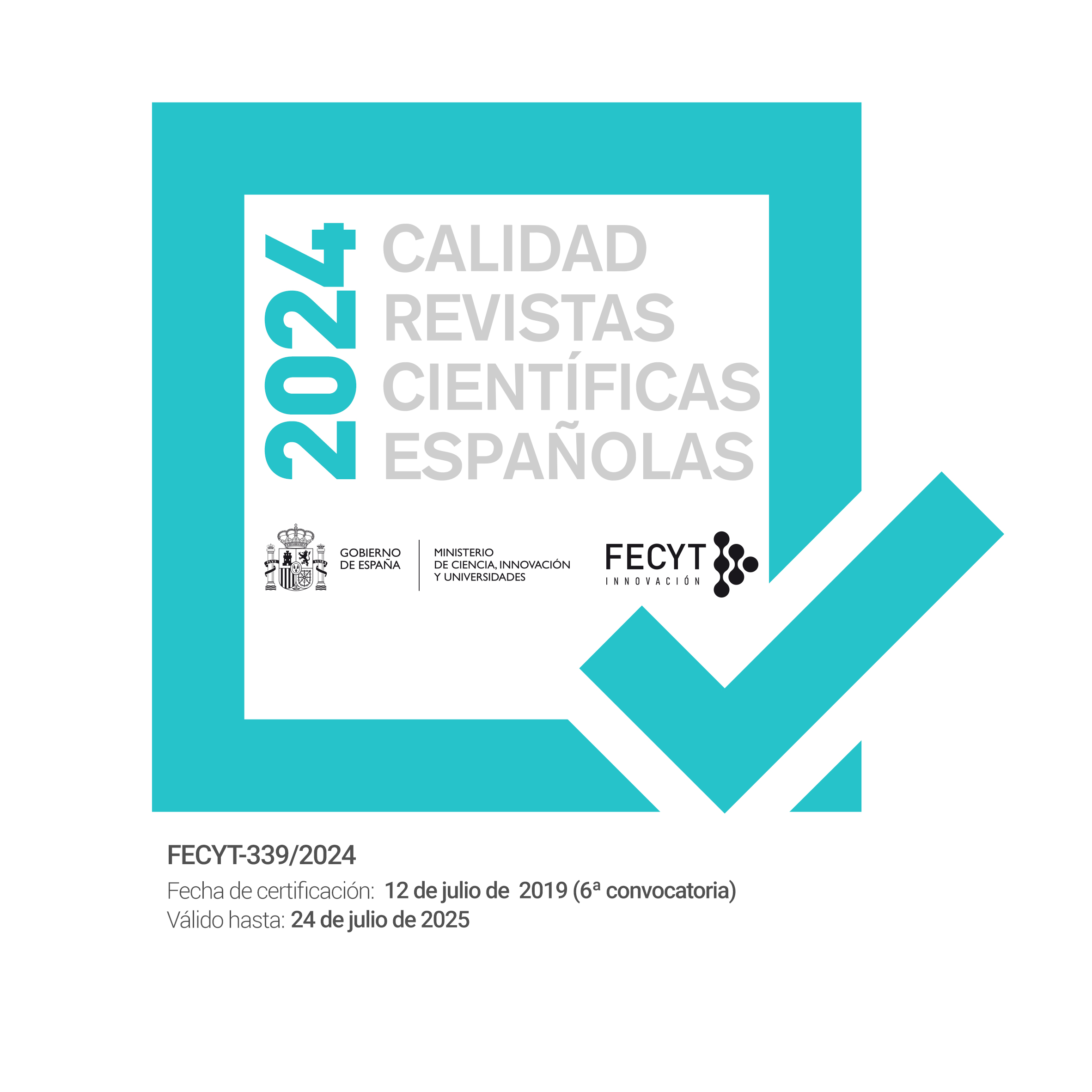Topology as Access to Lacanian Theory
DOI:
https://doi.org/10.24310/Claridadescrf.v13i2.8542Keywords:
psychoanalisis, Lacan, topology, Borromean ring, DesireAbstract
This paper carries out a reading of Lacan’s work by the study of its topological figures. Thus, it is stated that Lacanian Psychoanalisis does not take Topology as an external tool in order to bring some exemples and explanations; rather, Lacanian thought is itself topological and therefore it cannot be understood aside
from this dimension which goes through all its path. In order to do so, we will study six figures: the graph of desire, Moebius strip, the torus, Klein bottle, the sphere with a cross-cap and the Borromean ring.
Downloads
Metrics
Publication Facts
Reviewer profiles N/A
Author statements
Indexed in
-
—
- Academic society
- N/A
- Publisher
- Asociación para la promoción de la filosofía y la cultura en Málaga (FICUM) y UMAEditorial
References
Amster, P. (2010): Apuntes matemáticos para leer a Lacan. Buenos Aires: Letra Viva.
Cao, J. (S.F.): «Mathematizing the Limits of Time: Heidegger, Derrida and the Topology of Temporality», Math.HO (arXiv:1910.05359).
Couto Triska, V. H. y Leao D’Agord, M. R. (2013): «A topologia estrutural de Lacan», Psicologia Clinica 25-1, pp. 145-161.
Couto Triska, V. H. y Leao D’Agord, M. R. (2018): «The scientific roots of Lacan’s structural topology», Ágora 2 mayo/agosto, pp. 224-232.
Darmon, M. (2008): Ensayos acerca de la topología lacaniana. Buenos Aires: Letra Viva.
Hoens, D. (2016) «Why Topology?» en M. Friedman y S. Tomsic (ed.), Psychoanalisis: Topological Perspectives. Bielefeld: Transcript.
Lacan, J. (1998): El Seminario XX. Aun. Buenos Aires: Paidós.
Lacan, J. (2003): Escritos. Buenos Aires: Siglo XXI.
Lacan, J. (2006): El Seminario XXIII. El Sinthome. Buenos Aires: Paidós.
Lacan, J. (2007a): El Seminario X. La angustia. Buenos Aires: Paidós.
Lacan, J. (2007b): El Seminario VII. La ética del psicoanálisis. Buenos Aires: Paidós.
Lacan, J. (2008a): El Seminario XVI. De un Otro al otro. Buenos Aires: Paidós.
Lacan, J. (2008b): El Seminario VIII. La transferencia. Buenos Aires: Paidós.
Lacan, J. (2009): El Seminario XVIII. De un discurso que no fuera del semblante. Buenos Aires: Paidós.
Lacan, J. (2010): El Seminario V. Las formaciones del inconsciente. Buenos Aires: Paidós.
Lacan, J. (2012): Otros escritos. Buenos Aires: Paidós.
Lacan, J. (2015): El Seminario VI. El deseo y su interpretación. Buenos Aires: Paidós.
Lacan, J. (S. F.) El Seminario IX. La identificación. Edición Crítica de Ricardo E. Rodríguez Ponte.
Miller, J.-A. (1998): Los signos del goce. Buenos Aires: Paidós.
Miller, J.-A. (2003): «Mathemes: Topology in the Teaching of Lacan» en E. Ragland y D. Milovanovic (ed.), Lacan: Topologically speaking. New York: Other Press, pp. 28-48.
Miller, J.-A. (2007): Dos dimensiones clínicas: síntoma y fantasma. Buenos Aires: Manantial.
Miller, J.-A. (2009): De la naturaleza de los semblantes. Buenos Aires: Paidós.
Miller, J.-A. (2011): La experiencia de lo real en la cura psicoanalítica. Buenos Aires: Paidós.
Miller, J.-A. (2013): La angustia lacaniana. Buenos Aires: Paidós.
Miller, J.-A. (2014): El ultimísimo Lacan. Buenos Aires: Paidós.
Monteiro, M. P. (2014): «A topologia de Lacan», Estudos de Psicanálise 41, pp. 133-140.
Nasio, J.-D. (2007): Topologería. Buenos Aires: Amorrortu Editores.
Palombi, F. (2009): «Neither inside nor outside. Consideration on the structure of the subject and of language in Jacques Lacan», Ethics & Politics XI-1, pp. 351-360.
Downloads
Published
How to Cite
Issue
Section
License
Esta revista provee acceso libre inmediato a su contenido bajo el principio de hacer disponible gratuitamente la investigación al público. Todos los contenidos publicados en Claridades. Revista de Filosofía, están sujetos a la licencia Creative Commons Reconocimento-NoComercia-Compartirigual 4.0 cuyo texto completo puede consultar en <http://creativecommons.org/licenses/by-nc-sa/4.0>
Es responsabilidad de los autores/as obtener los permisos necesarios de las imágenes que están sujetas a derechos de autor.
Los autores/as cuyas contribuciones sean aceptadas para su publicación en esta revista conservarán el derecho no exclusivo de utilizar sus
contribuciones con fines académicos, de investigación y educativos, incluyendo el auto-archivo o depósito en repositorios de acceso abierto de cualquier tipo.
La edición electrónica de esta revista esta editada por la Editorial de la Universidad de Málaga (UmaEditorial), siendo necesario citar la procedencia en cualquier reproducción parcial o total.

















6.png)
